These over 50000 stone statues are the greatest legend of Chongqing in this world
Beita Chunyun Luo Country/Photo
In 1940, Liang Sicheng brushed aside the overgrown weeds and sat down on a scattered stone, carefully gazing at the statues around him. That is a late Tang Dynasty statue, frozen in time by the camera.
More than 70 years later, this photo was included in Liang Sicheng's book "The History of Buddha Statues".
In that shot, Liang Sicheng is in Dazu and Beishan.

No. 49-55, Fowan South District, Beishan. China Architecture Society, photographed by Liang Sicheng, Liu Dunzhen, and others in 1940
Dazu Rock Carvings has always been a special existence for Chongqing and even the whole China.
In fact, the outside world's understanding of Dazu Rock Carvings has never been fully understood.
Even though the purpose of this article is to prepare to present all the beauty of the Dazu Rock Carvings to people, there is no doubt that we can only do a little because of the space limitation.
As the saying goes, "God's creatures prefer here", Dazu Rock Carvings bear more than 50000 cliff statues in total, and it is also the ancestors' expectations for the beauty of the world and all traditional virtues since the Tang Dynasty. These cliff statues are not only the shapes and characters carved on the mountain walls, but also the monuments about stone carvings belonging to Chongqing, China and the world.

No. 29, Dafo Bay, Baoding Mountain - Courtesy of Dazu Rock Carvings Research Institute, Yuanjue Taoist Center
In 1999, Dazu Rock Carvings were listed in the World Cultural Heritage, which is the recognition of the whole world for the Dazu Cliff Statue, and also the origin of the phrase "North Dunhuang, South Dazu". The Dazu Statue, which is equally famous with the Mogao Grottoes of Dunhuang, Yungang Grottoes, and Longmen Grottoes, is still as beautiful and smiling as it has been every day for more than a thousand years.
Perhaps only by truly approaching these cliff statues can one truly feel the beauty of the frozen human world.
01 Starting point of Dazu Cliff Carvings
Let's cross the current of time and start tracing the history of Dazu.
According to Mr. Bo Yang's classification of historical periods in "Outline of the History of Chinese People", China is divided into mythological era, semi historical era, and historical era. The Xia and Shang dynasties were the beginning of the historical era. In that era, Dazu had already engaged in human activities and was administratively under the jurisdiction of the State of Ba. In 316 BC, the State of Ba was destroyed by the State of Qin, who established Ba Commandery in present-day Jiangzhou (Yuzhong District), and Dazu became part of Ba Commandery. This marked the beginning of Dazu's entry into the mainstream cultural system.

The image is sourced from the internet
For Dazu, the milestone year was 758 AD, when Emperor Suzong of Tang Dynasty, Li Heng, was in power. At that time, the An Lushan Rebellion was coming to an end, and Li Yu was appointed as the crown prince. Dazu was officially established as a county in this year. Due to the presence of Dazu River in its jurisdiction and the current war, the court hoped for a "prosperous Dazu" in the world, so the newly established county was named Dazu.
This name has been used until today.

The image of Jianshanzi Cliff Carving is sourced from the internet
The beginning of Dazu Rock Carvings was the Jianshanzi Cliff Statue which started in 650 AD (the first year of Yonghui in the early Tang Dynasty) and flourished in the 9-10 century AD.
The 9th and 10th centuries AD were the end of the Tang Dynasty, when the governor of Changzhou, Wei Junjing, ruled over Dongchuan and stored troops and grain in Dazu. Wei Junjing was originally a guest from Shaanxi and was a local official. After the An Lushan Rebellion, he took advantage of the turbulent situation and captured Dazu. He served as the governor of Changzhou and was appointed as the commander of the four provinces of Chang, Pu, Yu, and He. He became a local hegemon under the name of "Jiedushi" and established Yongchang Fort on today's Beishan.

The image of Jianshanzi Cliff Carving is sourced from the internet
It is said that Wei Junjing was infected by Buddhism. He felt that he had committed countless crimes of killing people in the army and tried to atone for his sins. He dug the King of Heard on the stone wall of Longgang Mountain at that time. Longgang Mountain is now the North Mountain of Dazu. The King of Heard was considered the beginning of Dazu Rock Carvings.
02 The Last Monument in the History of Chinese Grottoes
Wei Junjing, who was sculpting on the cliffs of Beishan, never imagined that his unintentional action would create the glory of Dazu more than a thousand years later.
After Wei Junjing completed the statue of Duowen Tianwang, local officials, monks, and nuns followed suit and began the vigorous Beishan Cliff Carving Movement, which lasted for more than four hundred years. Although it experienced changes in time and dynasties, it never stagnated.
The location of the statues extends from Beishan to Baoding Mountain, Nanshan Mountain, Shizhuan Mountain, and Shimen Mountain, forming a large group of cliff statues with over 50000 statues, making it one of the eight major grottoes in the world.

Panorama of Baodingshan Dafowan Grottoes Courtesy of Dazu Rock Carvings Research Institute
From the Tang Dynasty, through the five dynasties and ten countries, until the Chunyou period of the Southern Song Dynasty, there were nearly ten thousand statues of gods and gods in Dazu Rock Carvings. They were lively in joy and anger, and exquisite in carving flowers, birds, fish and dragons, which was brilliant and shining.
Wandering among the stone carvings, first take a look at the instructions on the signboard, calculate their age, and then face over a thousand years of time, looking up in admiration - there used to be axes and chisels that spanned over a thousand years here.

Panoramic View of the North Mountain Wheel Scripture Cave by Luo Guoguo/Photo
It has to be said that the Dazu Rock Carvings represent the highest level of world grotto art from the 9th to the 13th century AD. Before that, the two peaks of statues in China were around the 5th and 7th centuries AD. But by the middle of the 8th century AD. (after Tang Tianbao), they had declined.
At this juncture, Dazu Rock Carvings, represented by the "Five Mountains" cliff carvings, were built from the end of the 9th century to the middle of the 13th century, which formed another peak in the history of Chinese grotto art, thus extending the history of Chinese grotto art for more than 400 years.

Dazu Rock Carvings Art Museum Luo Guoguo/photo
03 Dazu Rock Carvings Tears at the Highest Tone
We can see the earliest stone statues, with faint shadows of northern statues. The statues are drawn with deep lines and rough strokes, with a strong sense of three dimensionality, rich colors, and bold brushstrokes that resemble the style of swords and knives. At that time, Buddha statues will come from the banks of the Ganges River and be introduced to China along the Silk Road.
With the infiltration of the Tang Dynasty into the world, as time passed, the statues presented a pure joy. People raise chickens, play the flute, and herd cattle, and Guanyin also has a seductive demeanor. Those gods and Buddhas, with calm and natural expressions, seem never to be aloof, just like ordinary people, with vivid expressions and a lively optimism.
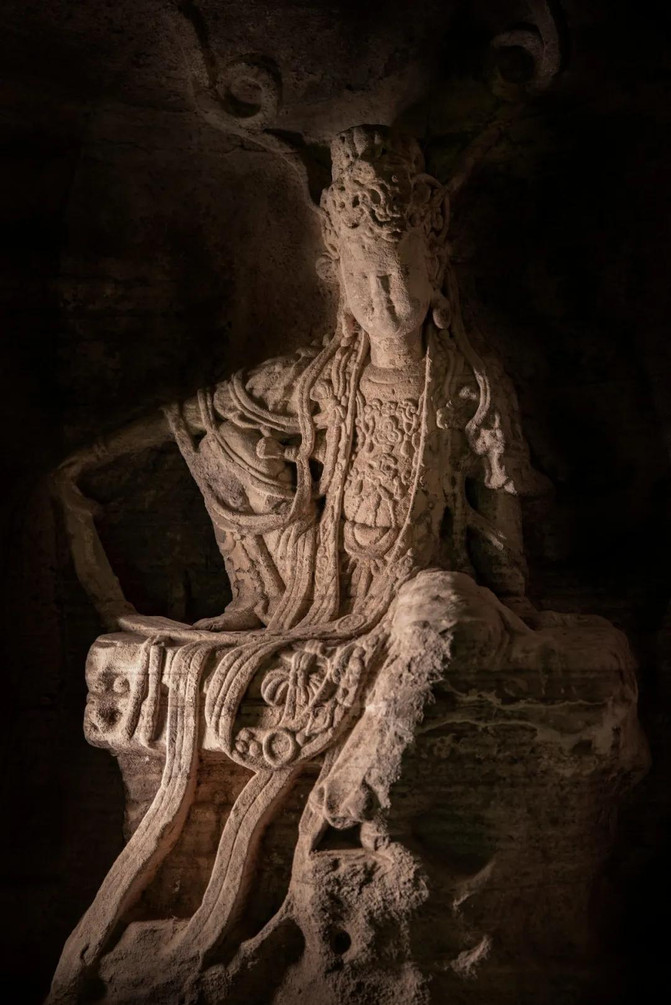
Beishan Shuiyue Guanyin Temple Luo Country/Photo
There are also more stories about ordinary people, and the figures in the world are becoming increasingly petite, slender, and rounded, with the style of small passenger statues from Southeast Asia, South Asia, and ethnic minority areas such as the Dai people in Yunnan, China, which are imbued with the strong atmosphere of the Southwest Silk Road.
From the Tang Dynasty to the Song Dynasty, it became increasingly magnificent. In the statues of the Song Dynasty, all birds and birds are dancing happily, and flowers are rolled into a cascade of patterns. The No. 245 Guanwuliang Shou Buddhist Sutra is a disguised form, with 539 statues of figures and over 460 objects of various kinds. The art of martial arts and music, as well as the pavilions and towers, are neither rigid nor repetitive, blending seamlessly into a lively and vibrant whole.

Beishan Wheel Scripture Cave - Sun Moon Guanyin Luo Country/Photo
The last person worth remembering is Zhao Zhifeng. Starting at the age of twenty, he preached on Baoding Mountain in Dazu and spent over 70 years excavating grottoes and building a tantric temple on the mountain. He walked to the end of his life, still leaning against the mountain wall every day, watching as the last part of the "Ten Great Ming Kings" in Baoding Dafu Bay took shape day by day.
But at that time, the Mongol army was attacking Sichuan, and Dazu was not spared. There were sporadic wars lingering around, and the most vivid carving of the "Great Dirt Trace Ming King" left unfinished axe and chisel marks under its body. After these marks, the stone carvings in Dafowan came to an abrupt end.
The day when the stonemason put down the chisel is unknown. No one knows that the end of that day was the last climax in the history of grottoes in China and even the world. Dazu Rock Carvings stayed at the highest level of grotto art in the world from the 9th to the 13th century after six dynasties.

The image of the Great Dirt Trace Mingwang comes from the internet
All stone carvings from then on to the present day will never regain their former glory.
The localization process of 04 Dazu statue making techniques
Art is a demand for human stability, and the magnificent and large-scale grotto statues appeared at the moment of music and dance. Dunhuang is a necessary path on the Silk Road, where various cultural arts converge and settle into the Mogao Caves. The Northern Wei established its capital in Pingcheng, allowing the wealth of the entire country to gather in this area, thus giving rise to Yungang.

Beishan Guanjing Bianluo Country/Photo
After the An Shi Rebellion, the focus of Buddhism moved to the Bashu area, and the Buddhist culture of the south and the north converged. Many scholars, scholars, famous craftsmen also came to the Bashu area with Emperor Xuanzong of the Tang Dynasty, bringing the first artistic peak of Dazu Rock Carvings.

Baoding Mountain Pilu Dojo Luo Country/Photo
Whether from Leonardo da Vinci or Raphael, art often begins with religion.
The origin of Yungang Grottoes dates back even earlier. At that time, the gods and Buddhas had just risen from the banks of the Ganges River and arrived in China. They had the appearance of Hu and Fan, with some characteristics of the Xianbei people. When they arrived at Longmen Grottoes, their appearance gradually became dignified, with short legs and a long body, carrying the calm and leisurely demeanor of Central Plains people. After coming to Dazu, I became more and more cheerful, which is due to the sinicization of Buddhism.
Buddhism is spreading more and more widely in China, providing a light of the other shore for the common people, and the image of Buddha is becoming increasingly Chinese. But more importantly, it is due to the confidence of the prosperous Tang culture.
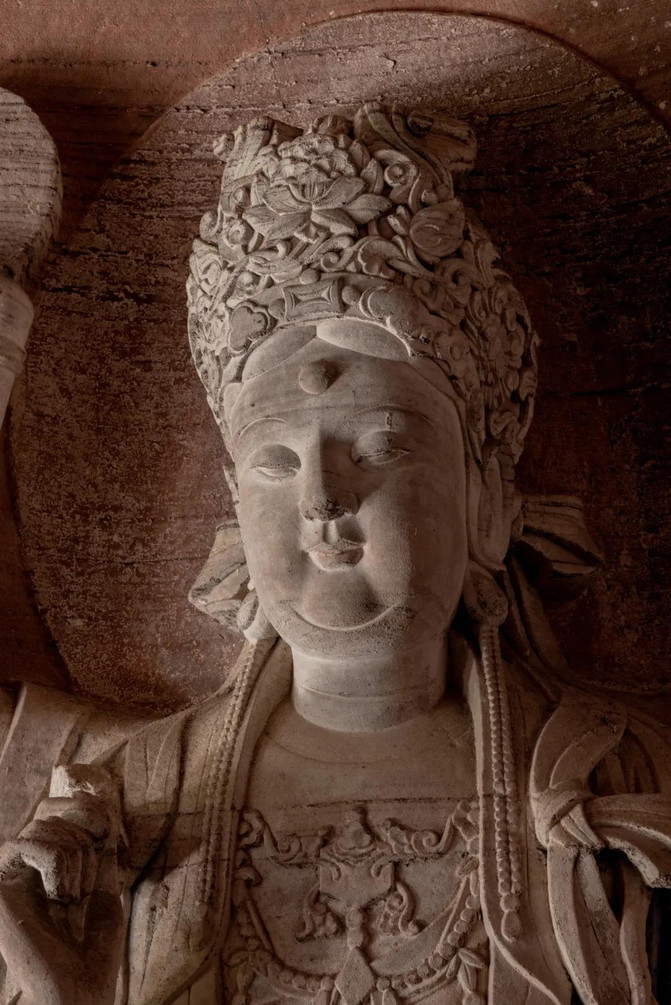
Rotating Wheel Scripture Cave - Portrait of Sun Moon Guanyin by Luo Guoguo/Photo
The Buddha Nirvana statue, which was referred to by Liang Sicheng as a "chiseled Buddha Nirvana statue on a cliff stone, with a truly magnificent appearance, almost the first in China," is not actually a Buddha Nirvana statue carved based on the standard model of a full body statue.
During the Song Dynasty, craftsmen carved the entire statue up to the legs, with the Buddha lying on his right side. The entire Buddha statue sank deep into the ground and weighed as heavy as a giant mountain. In terms of art, this sculptural style that replaces reality with virtuality is very similar to the technique of leaving blank space in Chinese painting.
In terms of doctrine, such a deep and lonely Nirvana image is so pure in mind and body.

In the documentary Dazu Rock Carvings of CCTV, taking the precious craftsman's inscriptions on Dazu Rock Carvings as clues, the general appearance of this group in the Song Dynasty was outlined: Wen, who has inherited more than 180 years, Fu, who is highly skilled, and Xu An from the Central Plains. It is these masters who have long been unable to verify their voices and faces that have achieved this final peak in the history of Chinese grotto art.
05 Beauty is from the Heavenly Palace to the Homestead
For six whole dynasties, in Dazu, Confucianism, Buddhism, and Taoism freed themselves from profound mysteries.
This is probably because as soon as Buddhism entered China from India, it immediately understood that this is a country that requires storytelling. Generation after generation of statues in the grottoes are portrayed with profound and popular dignity, smiling. People interpret karma, seeking blessings and disaster relief, providing adequate clothing and food, and the kindness of parents... Gradually, more and more stories are connected to the bloodline of Chinese history.
In religious stories, there are some popular themes among the general public: the statue of the "Prince Bathing in Nine Dragons" depicts the scene of nine dragons bathing the newborn Prince Siddhartha. The cliff with a top height of 6.40 meters features a large dragon head carved from a high point. The dragon mouth is wide open, and a clear spring flows out. This was once a clear spring in the mountains, which was used by craftsmen to lead into the dragon mouth.
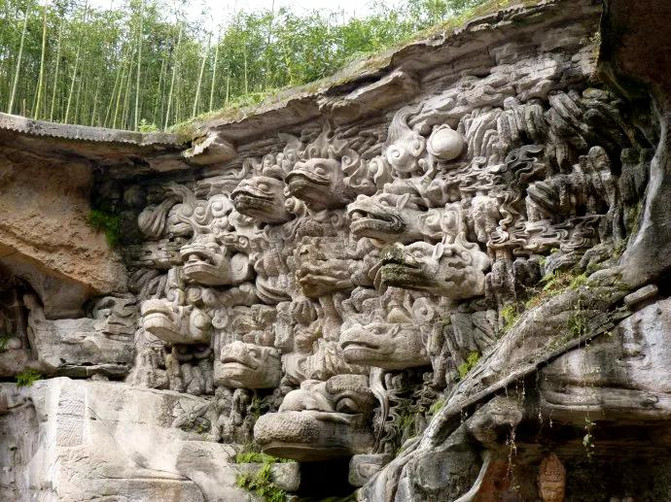
The image of the Prince of Kowloon Bath statue is sourced from the internet
In addition to religious stories, life themes are also quite vivid.
The Classic of Parents' Benevolence is divided into two layers, with 11 sets of statues depicting the 10 virtues of Confucian filial piety. The story begins with a couple who cast their heads to Buddha and pray for the passing of their children. The young man and woman devoutly worship Buddha, hoping to have a lovely child. Then, the mother becomes pregnant, suffers during childbirth, and the young couple hold their child in joy. As the child grows up, they tearfully bid him farewell and embark on a long journey

Baoding Mountain Chicken Raising Girl Luo Country/Photo
The cliff carvings on Baoding Mountain reflect a wide range of social life scenes. Princes and ministers, fishing, farming, woodcutting, and reading, all kinds of characters are about to emerge.
Wang Zengqi once said that the statues in Dazu Rock Carvings are "full of humanity", and the stone carvings here are really full of life color - the Buddhist theme has become a reality, the heaven has become a courtyard, bustling with joy, and also contains the earnest exhortations of benevolence, righteousness, kindness and filial piety.

Baoding Stone Carvings Snow Scenery Luo Country/Photo
Standing in front of these stone carvings and gazing, it seems like one can return to the past scene. In the course of thousands of years, Dazu Rock Carvings have recorded and happened stories.
The mortals on the stone wall stayed in that era, and the spectators below the stone wall came and went. There were various forms of worship for gods and Buddhas, as well as daily entertainment and sightseeing. However, this popular orientation did not reduce it to a rural temple fair. Time left sculptors, craftsmen, high monks, and pilgrims passing by; The air was once filled with Buddhist chants, wooden fish, and the laughter of the people.
From the heavenly court to the courtyard, the life of Dafeng Dazu is frozen in the wind of the cliff.
Each of the five mountains has its own beauty
As described earlier in this article: 1940. Liang Sicheng brushed aside the overgrown weeds and sat down on a scattered stone, carefully gazing at the statues around him. That is a late Tang Dynasty statue, frozen in time by the camera. The scene takes place in Fowan, Beishan.
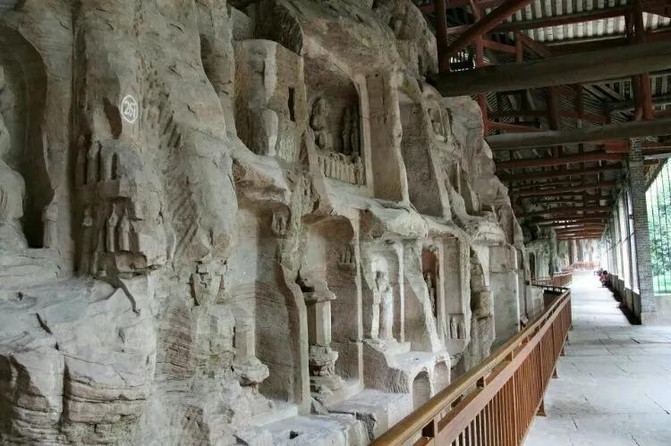
The image of Beishan Moyan statue is sourced from the internet
The Beishan Cliff Carvings are still considered to have the highest artistic value. Because the statues here are mostly carved for those who wish and fulfill their vows, and because of a devout heart, all those entrusted are the most outstanding craftsmen of that time.
In Beishan, Fowan is arranged in a straight line, with more than 7000 statues, including the ancient filial piety stele that reads "This is the only moment in the world", the famous "Wheel Sutra Collection" statues from China and abroad, and the Samantabhadra statue known as the "Oriental Venus".

The image of Beishan Moyan statue is sourced from the internet
If the artistic value of Beishan stone carvings is strong, Baoding is even more down-to-earth. The vivid and lively themes repeatedly mentioned in various media outlets are mostly from Baoding, with vivid stories and various clever ideas, allowing Baoding to enjoy greater appeal.
Baoding is a large esoteric Buddhist temple built by the famous monk Zhao Zhifeng of the Southern Song Dynasty for more than 70 years. It is centered around Dafowan and excavated along the horseshoe shaped natural rock wall, with nearly ten thousand cliff statues.

Baodingshan Dafowan Luo Country/Photo
Dafu Bay is about 500 meters long and 15 to 30 meters wide. The carved statues include more than 30 grand cliff and cave statues, including the Eight Great and Six Links Protectorate Statue, the Six Wonders of Mind, the Great Buddha Sutra Transfiguration, and the Thousand Armed Guanyin Statue. The completeness of its content is almost complete, encompassing all the teachings of a generation, including everything recorded in Buddhist scriptures
During the Yuan and Ming dynasties, Dafowan suffered several military disasters, but the stone carvings are still intact today. The entire statue is like a long scroll painting unfolding, among which the most famous are the Song Dynasty Buddha Nirvana statue, the Three Saints of Huayan, the Cowherd statue, and the Three Grades and Nine Lives statue.

Baoding Mountain Huayan San Shengluo Country/Photo
Nanshan is a concentrated area for Taoist stone carvings and sculptures. Started in the Northern Song Dynasty and extended to the Ming and Qing Dynasties. There are more than 500 Taoist statues such as Sanqing and the Flying Dragon of the Holy Mother, as well as the "Sanqing Hall", "Taiqing Pavilion", "Zhenwu Cave" and the historically valuable "He Guangzhen Stele". Taoism regards clothing and crowns as rituals, and the costumes of the Nanshan statues are magnificent, which has important reference value for clothing research.

Nanshan Grottoes No. 5- Tour Map of Sanqing Grottoes' Heavenly Buddha Courtesy of Dazu Rock Carvings Research Institute

Nanshan Grottoes No. 5- Courtesy of Dazu Rock Carvings Research Institute of Sanqing Grottoes
The construction of Shimen Mountain began in the Northern Song Dynasty and is a sculptural area shared by Confucianism, Buddhism, and Taoism. More than 300 immortals, jade emperors, Buddhas, Bodhisattvas, and officials of the emperor gathered together, demonstrating the Chinese people's warmth and generosity towards faith.

Shimen Mountain Sanhuang Cave Luo Country/Photo

Shimen Mountain Peacock Ming King Luo Country/Photo
There is a temple on Shizhuan Mountain, and outside the temple is a hidden stone carving area. Four to five thousand Buddha statues are carved from a mixture of Confucianism, Buddhism, and Taoism. The statues of Confucius and his ten disciples are rare, and the nearby Cave 8 contains seven statues of Laozi and his seven true masters standing on each side.
The excavators of time, with incredible determination, have created a massive group of Chinese Buddhist cliff carvings.

Shizhuan Mountain Three Body Buddha niche Luo Guo/Photo
07 restored human treasures
In December 1999, Dazu Rock Carvings, represented by the "five mountains" of Baoding Mountain, Beishan Mountain, Nanshan Mountain, Shimen Mountain and Shizhuan Mountain, was included in the The World Heritage List by UNESCO and became the only world cultural heritage in Chongqing.
At the same time, Dazu Rock Carvings has entered a high-speed weathering period due to the long excavation time and natural stress and other factors.
The most complex and beautiful Thousand Armed Guanyin has a carving area of 88 square meters, with a total of 830 hands and eyes carved on the cliff face behind it. It combines sculpture, painting, and gilding, and is full of grandeur. However, due to years of wind and rain, it has been severely eroded by time and has undergone varying degrees of weathering. Some of the stones on the face and hands have turned into debris and fallen off one after another.

Baoding Mountain Thousand Hand Guanyin Luo Country/Photo
In May 2008, the National Cutural Heritage Administration designated the restoration project of Dazu Rock Carvings Thousand Hand Guanyin as the "No. 1 Project" of national stone cultural relics protection, and organized experts for consultation.
In April 2011, Qianshou Guanyin began to initiate comprehensive restoration, with the idea of addressing the root cause first, which is to reinforce severely weathered rock masses without damaging the surface gold foil; Post treatment table, including procedures such as gold foil pasting, color painting restoration, and missing part repair.
Since then, the restoration experts from the Chinese Cultural Heritage Research Institute, the Dunhuang Research Institute and the Longmen Grottoes, together with the staff of the Dazu Rock Carvings Research Institute, have formed a restoration team of more than 20 people.

On June 20, 2014, the restoration personnel of Thousand Hand Guanyin took a photo with Luo Guoguo
It is difficult to restore the original artist's ideas throughout the dynasties. In 2019, young experts in Chongqing proposed a new suggestion: based on computer imaging, simulate the overall proportion of the printed object, replicate the missing parts of the stone statue, and then use modern 3D printing technology to print out the incomplete parts of the stone statue.

On March 31, 2015, we entered the final stage of "skincare", and the sealing agent was like a "skincare cream" that could provide good protection for the "skin" of Thousand Hand Guanyin.
With the support of 3D technology, restoration experts studied the style of stone carvings from the Tang and Song dynasties, and 3D printed small damages such as stone chips and debris on the Thousand Hand Guanyin stone carvings using stone materials. These high-tech fragments were bonded to the damaged areas, and in less than a month, the restoration work of the Thousand Hand Guanyin stone carvings was completed.
Now, the restored Thousand Armed Guanyin has regained its original lines, achieving a miracle in history through modern technology and classical craftsmanship.

Baoding Mountain Thousand Hand Guanyin Luo Country/Photo
The willingness of ancient people and the ingenuity of modern people, the craftsmanship of the past and the scientific research of the present, have conveyed the respect for art in different ways in different eras. Time flies and stars move, and human skills shine with different brilliance time and time again. Both ancient and modern people cherish those treasures together.
The unchanging mountains and rivers, because of their silence, appear even more profound.
————————
Introduction to Dazu Rock Carvings
Transportation
Self driving: It takes about one hour to navigate Dazu Rock Carvings from the main city of Chongqing;
Public transportation: Take shuttle buses from major bus stations in Chongqing to Dazu District, with dozens of trips per day and a 1.5-hour journey. After arriving at Dazu Bus Station, transfer to Bus 205 to go to Baodingshan Stone Carving Scenic Area. You can take a taxi to the Beishan Stone Carving Scenic Area, which costs around 10 yuan.
admission ticket
Baoding Mountain ticket is 115 yuan, Baoding+Beishan 140 yuan, half price for students and elderly people aged 60-64, free admission for elderly people aged 65 and above, and free admission to the Stone Carving Museum with scenic spot tickets. Tourist guide costs 150-200 yuan, and there will be different discounts for OTA website reservations.
Opening hours: 9:00-18:00, closing at 16:30
get accommodation
Kaiyuan Temple Hotel in Dazu Rock Carvings, Chongqing: 400 yuan per capita. The luxury hotel in Baodingshan Stone Carving Scenic Area is antique and within walking distance.
Songtang Bieyuan Hotel: 200 yuan per person, located near Changzhou Ancient City and Xiangguo Park, with a unique garden landscape and free Hanfu for guests to take photos.

Songtang Bieyuan Hotel
Huadi Dynasty Hotel: 400 yuan per person, a well-established first-class hotel in Dazu urban area, convenient transportation, close to scenic spots, and rich breakfast options.
Zhe Fei Hotel: 1.5 kilometers away from Beishan Stone Carvings, about a 15 minute walk away. It offers free parking, 24-hour coffee service, and buffet breakfast.
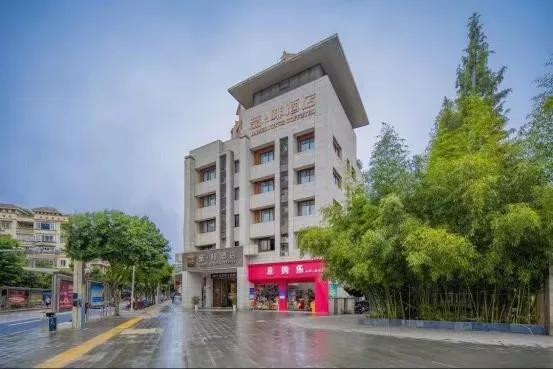
Zhe Fei Hotel
periphery
Changzhou Ancient City: a national 3A level tourist attraction, located around the Dazu urban area, is a historical and cultural city with the theme of "Song style and Song charm". The ancient city is built along the river and includes the Changzhou government office, the National Studies Museum, the stage, the embroidery tower, and the Changzhou city tower, which is about 13 meters high. It is a three-dimensional "Qingming Riverside Scene".

Changzhou Ancient City
Nanshan Park: Covering an area of more than 1700 mu, located at the south end of the urban central axis, it is an open comprehensive urban forest park integrating Dazu Rock Carvings culture and natural ecological scenery, and integrating ecological leisure, fitness, science popularization and cultural education.

Namsan Park
Xiangguo Park: Adjacent to the ancient city of Changzhou, it is the largest comprehensive park in the area. The antique style buildings in the park are highly distinctive, and the landscape of small bridges, flowing water, waterfalls, pavilions, and other mountains and waters is one step at a time, making it refreshing to enjoy.

Xiangguo Park
Dazu Science and Technology Museum: Closed on Mondays and Tuesdays, open for free from 10:00-17:00 on Wednesdays to Sundays. There are 7 permanent exhibition halls, 1 temporary exhibition hall, and 1 science popularization cinema in the museum. Currently, it is the largest district level science popularization venue in Chongqing, where both adults and children can experience the wonders of technology.

Dazu Science and Technology Museum
Longshui Lake: "Dazu West Lake", a line between water and sky. There are 108 small islands scattered throughout the lake, allowing tourists to enjoy the beautiful scenery of the lake by boating, as well as experience various jungle adventure projects such as live CS, jungle jumping, archery, and more on Songhe Island. The nearby Xunlong Water Park and Longshui Lake Hot Spring Water World perfectly meet tourists' expectations for "water play".

Longshui Lake
delicious food
Rabbits: Defu Street Rabbit, Dragon Sailor Tear Rabbit, Yongxi Water Mouth Rabbit
Fish: Youting crucian carp, Wenjia fatty intestinal fish, fish ah fish, Gongdu sour soup fish mansion (or Liu Wu stick sour soup black fish), frog and fish, Xiao crucian carp
Jianghu cuisine, barbecue, small seafood, etc.: Fire pot barbecue, Kan Shang Jianghu cuisine, Hetang Xiaoyuan hotpot, Li Laoren local restaurant, Second Senior Brother barbecue, Hokkaido seafood stall

Kan Shang Jianghu Cuisine
Chinese style stir fry: Fafa stir fry, Yixiangju stir fry, fresh kitchen Chinese cuisine
Snacks: Dingjiapo Potato, Qiangqiang Potato, Juntun Guokui, Longshui Shredded Pork Rice Noodle, Laozhangjia Mutton Rice Noodle, Crossing the bridge noodles, Jiaotong Noodle, Piaoxiang Noodle, Guoxing Noodle, She Fatty Vegetable Cold Shrimp, Guochun Cold Cake, Quality Cold Shrimp, Spicy dried tofu

Longshui shredded pork rice noodles
specialty
Dazu Black Mountain Lamb: Dazu Black Goat is a national level livestock and poultry genetic protection resource, formed through long-term reproduction and natural closed breeding. It has the characteristics of large body, fast growth and development, and high reproductive capacity. The quality of Black Mountain Lamb is fresh and tender, with a small gamey taste, which is in line with the taste of consumers in the southwest region.

Dazu Black Mountain Lamb
Flute Girl Daqu: Local brewing has the advantages of excellent water quality, clear ingredients, good koji, and mature cellar. This wine is a strong aroma type with a 60 degree alcohol content. Its characteristics are mellow and refreshing, rich cellar aroma, harmonious flavors, and a long aftertaste.
Dazu Winter Cabbage: With a production history of over 100 years, it is made by pickling tender mustard greens for two to three years. The finished product has a brownish color, fresh and tender texture, rich aroma, crispy and sweet texture, and rich nutrition. It is a great seasoning for cooking and has been awarded the National Geographical Indication Certification Trademark.

Dazu Winter Vegetables
Dazu bamboo weaving: Dazu bamboo weaving has a long history, a wide variety of colors and varieties, exquisite textile craftsmanship, and is known as the "hometown of bamboo weaving". Bamboo strips and bamboo green cool mats are highly favored by tourists for their smoothness, softness, sweat absorption, heat dissipation, and coolness.
Three famous teas: Dazu pine tea, stone carved Sanming tea, and Baoding Kuding tea. Dazu is a famous specialty tea variety with a fragrant aroma, which is perfect for taking care of oneself and giving gifts.
